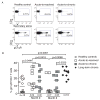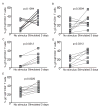Frequency of gC1qR+CD4+ T cells increases during acute hepatitis C virus infection and remains elevated in patients with chronic infection
- PMID: 19473882
- PMCID: PMC2720442
- DOI: 10.1016/j.clim.2009.05.002
Frequency of gC1qR+CD4+ T cells increases during acute hepatitis C virus infection and remains elevated in patients with chronic infection
Abstract
CD4+ T cell responses are impaired in chronic HCV infection. To determine factor(s) involved in CD4+ T cell dysregulation, we examined the effect of extracellular core on the alteration of CD4+ T cell responses and the cell surface level of core-binding protein, gC1qR on CD4+ T cells from acute HCV patients with resolved and chronic infection. During the acute phase of infection, the frequency of gC1qR+CD4+ T cells increased in both resolved and chronic HCV infection compared to healthy controls. Notably, 6 months later, the frequency of gC1qR+CD4+ T cells maintained elevated in chronic patients compared to that in resolved patients. In addition, TCR stimulation increased the frequency of gC1qR+CD4+ T cells, resulting in core-induced inhibition of T cell responses in both resolved and chronic patients. These results suggest that HCV infection expands gC1qR+CD4+ T cells, which increase the susceptibility to core-mediated immune dysregulation and facilitate the establishment of HCV persistency.
Figures





Similar articles
-
gC1qR expression in chimpanzees with resolved and chronic infection: potential role of HCV core/gC1qR-mediated T cell suppression in the outcome of HCV infection.Virology. 2006 Mar 15;346(2):324-37. doi: 10.1016/j.virol.2005.11.020. Epub 2005 Dec 20. Virology. 2006. Retraction in: Virology. 2007 Nov 25;368(2):432. doi: 10.1016/j.virol.2007.09.005. PMID: 16368125 Retracted.
-
Reduced naive CD4 T cell numbers and impaired induction of CD27 in response to T cell receptor stimulation reflect a state of immune activation in chronic hepatitis C virus infection.J Infect Dis. 2011 Mar 1;203(5):635-45. doi: 10.1093/infdis/jiq101. Epub 2011 Jan 10. J Infect Dis. 2011. PMID: 21220773 Free PMC article.
-
A novel assay for detection of hepatitis C virus-specific effector CD4(+) T cells via co-expression of CD25 and CD134.J Immunol Methods. 2012 Jan 31;375(1-2):148-58. doi: 10.1016/j.jim.2011.10.004. Epub 2011 Oct 12. J Immunol Methods. 2012. PMID: 22019644
-
HCV core protein interaction with gC1q receptor inhibits Th1 differentiation of CD4+ T cells via suppression of dendritic cell IL-12 production.J Leukoc Biol. 2007 Dec;82(6):1407-19. doi: 10.1189/jlb.0507268. Epub 2007 Sep 19. J Leukoc Biol. 2007. PMID: 17881511
-
Hepatitis C virus: immunosuppression by complement regulatory pathway.Viral Immunol. 2001;14(4):277-95. doi: 10.1089/08828240152716547. Viral Immunol. 2001. PMID: 11792059 Review.
Cited by
-
SpgC1qR interacts with WSSV VP28 exhibiting antiviral activity.Fish Shellfish Immunol Rep. 2022 Jan 24;3:100052. doi: 10.1016/j.fsirep.2022.100052. eCollection 2022 Dec. Fish Shellfish Immunol Rep. 2022. PMID: 36419614 Free PMC article.
-
Strategies to Circumvent Host Innate Immune Response by Hepatitis C Virus.Cells. 2019 Mar 22;8(3):274. doi: 10.3390/cells8030274. Cells. 2019. PMID: 30909456 Free PMC article. Review.
-
Hepatitis C virus proteins inhibit C3 complement production.J Virol. 2012 Feb;86(4):2221-8. doi: 10.1128/JVI.06577-11. Epub 2011 Dec 14. J Virol. 2012. PMID: 22171262 Free PMC article.
-
Identification of the gC1qR sites for the HIV-1 viral envelope protein gp41 and the HCV core protein: Implications in viral-specific pathogenesis and therapy.Mol Immunol. 2016 Jun;74:18-26. doi: 10.1016/j.molimm.2016.03.016. Epub 2016 Apr 23. Mol Immunol. 2016. PMID: 27111569 Free PMC article.
-
Adaptive immunity to the hepatitis C virus.Adv Virus Res. 2010;78:43-86. doi: 10.1016/B978-0-12-385032-4.00002-1. Adv Virus Res. 2010. PMID: 21040831 Free PMC article. Review.
References
-
- Folgori A, Spada E, Pezzanera M, Ruggeri L, Mele A, Garbuglia AR, Perrone MP, Del Porto P, Piccolella E, Cortese R, Nicosia A, Vitelli A. Early impairment of hepatitis C virus specific T cell proliferation during acute infection leads to failure of viral clearance. Gut. 2006;55:1012–1019. - PMC - PubMed
-
- Gerlach JT, Diepolder HM, Jung MC, Gruener NH, Schraut WW, Zachoval R, Hoffmann R, Schirren CA, Santantonio T, Pape GR. Recurrence of hepatitis C virus after loss of virus-specific CD4(+) T-cell response in acute hepatitis C. Gastroenterology. 1999;117:933–941. - PubMed
-
- Grant M. Secondary persistent infection with hepatitis C virus: a challenge for adaptive immunity. Lancet. 2002;359:1452. - PubMed
-
- Kaplan DE, Sugimoto K, Newton K, Valiga ME, Ikeda F, Aytaman A, Nunes FA, Lucey MR, Vance BA, Vonderheide RH, Reddy KR, McKeating JA, Chang KM. Discordant role of CD4 T-cell response relative to neutralizing antibody and CD8 T-cell responses in acute hepatitis C. Gastroenterology. 2007;132:654–666. - PubMed
Publication types
MeSH terms
Substances
Grants and funding
LinkOut - more resources
Full Text Sources
Medical
Research Materials
Miscellaneous

